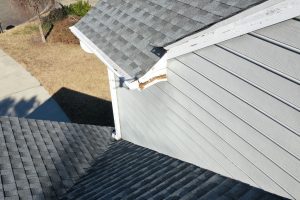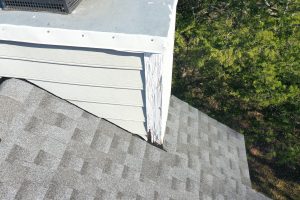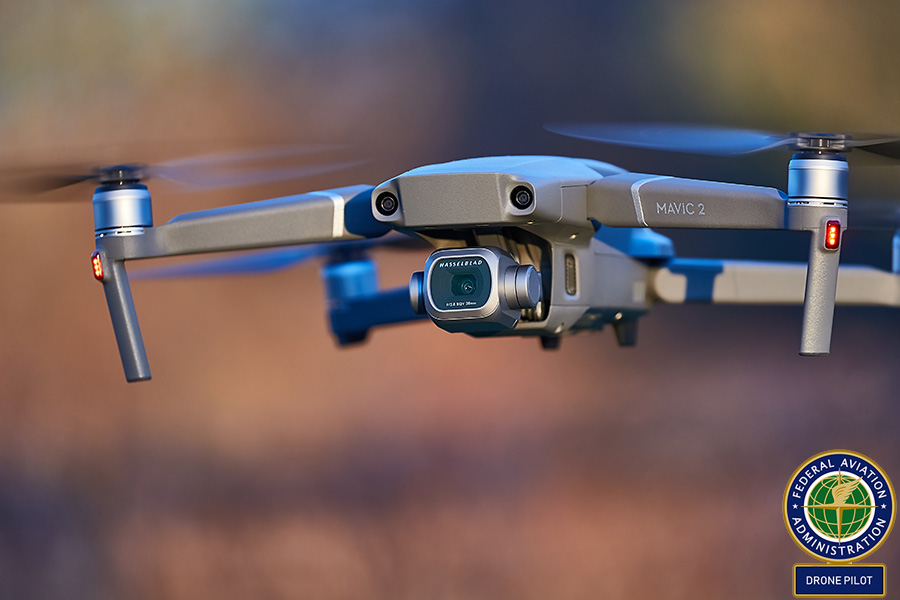Why Can’t You Walk On My Roof?
The NC Home Inspector Scope of Practice does not require an inspector to walk on a roof. This means that an inspector standing on the ground looking at the roof with his eyes, or a pair of binoculars, is all that is required. That inspector will not be able to see all aspects of a roof, especially if the slope of the surrounding ground will not afford him or her a good view. It isn’t safe to walk on roofs constructed with slate, tile, wood or metal, or roofs with too steep a pitch.
Every Roof is Accessible with a Drone
An aerial drone can fly and hover over any rooftop regardless of its size or condition. Whether your roof is brand new or damaged and deteriorating, a drone captures the details with color pictures or video.
Drones for Home Inspections Examine Hard-to-Reach Areas

This damage was not visible from the ground due to it facing the peak of the roof.
A home inspector may not be able to safely access all parts of your rooftop. Certain areas are too steep for foot traffic or, in some cases, too damaged to walk safely. This scenario calls for a drone’s assistance.
The inspector stays safely on the ground while directing the drone to hard-to-reach areas. It takes photos or video from several angles, providing a clear view of the roof and its condition.
Inspect Any Type of Roof
Sloped roofs are dramatic additions to any architecture. They also offer an easy pathway for rain or snow to fall to the ground. However, steep roofs are notoriously difficult to traverse on foot. Using drones for home inspections allows any roof to be examined, from peak to valley.
Aerial drones also let inspectors safely inspect damaged roofing or rooftop materials that may not hold up to foot traffic. Drones enable an inspector to check every rooftop for issues or defects, whether it’s shingle, tile, slate, or wood shakes.
Determine Damage Using Drones for Home Inspections
High-resolution images are standard with aerial drones. By zooming in on the image, a home inspector can find the smallest anomalies on the rooftop. A drone can identify problem areas that may result in leaks and water damage. The inspector may find roofing issues like missing or broken shingles, chipped tiles, or flashing that is rusting or missing.

The ground at the rear of this house was too low to have allowed the inspector to see this deterioration around the chimney without an elevated camera.
Drones for Home Inspections Provide Useful Information for Sellers or Buyers
When buying or selling a home, the homeowner and the buyer may not have all of the facts about the property. Determining the amount of damage in a corner of the rooftop can help you decide between roof repair or replacement. Drones for home inspections provide important information to sellers and potential buyers.
Moving Beyond the Structure
Some inspections will also survey the surrounding land on a property. Drones might fly over trees and nearby power lines in order to verify their spacing. Drones can be used to give a complete aerial view of the property and the neighboring areas.
Choose a professional who uses drones for home inspections. After the inspection, the home inspector will give you a detailed report with images of your property.
Central Carolina Home Inspections, LLC offers home inspection services to Central North Carolina. We have a license to operate a small Unmanned Aircraft System(sUAS), or drone, for use during a home inspection. Contact us to request an appointment.


Recent Comments